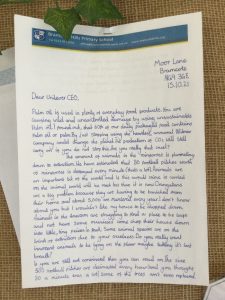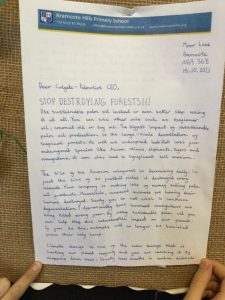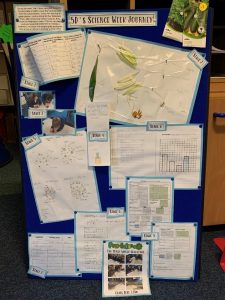
April 20, 2022, by Rupert Knight
The Power of an Immersive Curriculum
In this post, Thomas Dransfield, Class Teacher and Key Stage Leader at Bramcote Hills Primary School in Nottingham shares some examples of creating immersive environments across the curriculum.
Our SPARK Curriculum
In recent years, the curriculum has taken precedence amongst educational stakeholders, and rightly so, for it is the quality of a school’s curriculum which fosters children’s interests and broadens their knowledge. At Bramcote Hills, we have designed and implemented our ‘SPARK Curriculum’. This curriculum was first designed by the senior leadership team, who used best-practice research and examples from other schools as a starting point. The first draft was then shared with teachers and governors, who gave their input.

SPARK stands for:
• Stimulating: We use ‘hooks’ that excite, engage and inspire. We build on children’s interests. We provide opportunities to study some areas in more depth. We ensure breadth of curriculum to nurture a range of talents. We make good use of modern technology.
• Purposeful: We consider an end purpose to our topics in order to make learning real and motivational. We build on real-life experiences and develop key skills.
• Aspirational: We believe that all learners can achieve. We try to nurture a positive attitude to learning and the acquisition of key skills. We want children to spire to good employment. Our approaches are based on thorough research.
• Relevant: Our curriculum is based in the real world. It is designed to take account of barriers faced by our learners. It is current. It reflects our distinctive community and supports the personal development of our pupils.
• Knowledge-based: Children will develop their knowledge through a progressive curriculum which deliberately covers some areas in depth. We want children to learn to love gaining knowledge. The accumulation of knowledge is supported by the acquisition of key skills.
All sequences of learning will include each element of SPARK because we believe that these are the key ingredients for optimum learning. This curriculum has been held in high regard by our parents and other stakeholders. In fact, in our recent Ofsted report (October 2021), the HMI wrote:
‘…they have constructed an ambitious curriculum that sets out precisely what pupils should know, and when, as they journey through the school. In reviewing the curriculum, leaders were also keen to ensure that it reflects the school’s context and pupils’ needs. To that end, they have specified aspects of the curriculum to be studied in more depth, according to pupils’ interests and experiences.’
Immersing ourselves
In Year 5, our first immersive lesson was based on Juliane Koepcke, the lone survivor of a plane crash in the Amazon rainforest in 1971. We wanted children to write a diary entry from Juliane’s perspective but knew children’s vocabulary on this environment would be limited. To remedy this, we visited a local wooded area and explored it with our senses. In addition, we had quite a memorable picnic, which included crickets, mealworms and grasshoppers (all perfectly edible). Through this experience, children were able to generate a wealth of words and phrases that enriched their written work when back in the classroom.

The next immersive sequence of learning, and certainly my favourite, was our palm oil campaign. On a dreary Monday morning, children came into a classroom that was quite different from the norm. Chairs had been upturned, tree branches hung from the ceiling and most absurdly, there was poo on the floor! After a quick introduction, children used the clues around the classroom to predict what had happened over the weekend. After concluding that an animal had inhabited our classroom, Rang-Tan, a cuddly toy orangutan was revealed. Using the book ‘There’s a Rang-Tan in my Bedroom’ by James Sellick, children were introduced to deforestation and its impact on orangutans.
In the next lesson, children researched the effects of ‘dirty’ (unsustainably farmed) palm oil and collected facts and statistics that would support them in their subsequent writing. Then, after exploring persuasive features, children wrote letters to various companies who source their palm oil from unsustainable farmers. Once children had edited and published their letters, we shared them with the companies via Twitter. I was astounded at how passionate the children (including those who are often reluctant writers) were when writing their letters. The EEF (2021) state that children benefit from having a reason to write and someone to write for. After observing children’s enthusiasm and passion during this sequence, I whole-heartedly agree.


Most recently, the school held ‘STEMterprise Week’. Each year group was given a project to complete, centred on British Science Week’s theme of ‘Growth’. In Year 5, children were tasked with designing a healthy flatbread that could be sold from the school kitchen during lunchtimes. The week began with learning about the importance of healthy nutrition, which supported children when designing their flatbread recipes. Following this, children used their mathematical knowledge to conduct surveys, ascertaining which of their recipes was most popular. Lastly, children had the exciting task of baking the base of their flatbread before adding their healthy toppings. At the end of the week, all classes presented their creations – which ranged from smoothies to pasta dishes – alongside displays of their learning journeys at an after-school Science Fair which parents were invited to attend. Children were immensely eager and proud to showcase their projects and many parents commented on how enthusiastic children had been at home when discussing their learning.

Looking ahead
The pandemic changed classrooms drastically. Bustling environments became row upon row of children unable to talk too loudly or leave their seat. With restrictions easing this year, it has been our endeavour to bring immersive learning and creativity back into our classrooms so that we can provide children with captivating experiences that foster a love of learning.
Here are some things you could consider in your classroom:
• When planning your next sequence of learning, think about including an element of immersion that will ‘hook’ children’s interests. These experiences often take preparation (and time!) but the impact of them is well worth it.
• As well as providing children with stimulating experiences, give them a purpose for their work. This could include: displaying their work in your local community; writing a letter or email to a person of interest; showcasing their work at school event such as a fair or museum. You will find that children are far more motivated when they have audience for their work.
• Collaboration is key. Share your ideas with other staff and they may offer you ideas in return. At Bramcote Hills, we have a SPARK display in our staff room which teachers add to with the lessons they have provided their classes. I often look at this display for inspiration if I am struggling for ideas.
No comments yet, fill out a comment to be the first

Leave a Reply